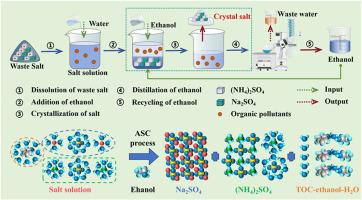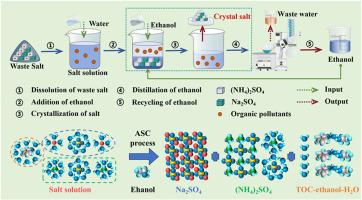反溶剂结晶法去除硫酸铵废盐中有机污染物及回收结晶盐
IF 10
1区 环境科学与生态学
Q1 ENGINEERING, ENVIRONMENTAL
引用次数: 0
摘要
工业废铵盐回收利用面临的主要挑战是有机污染物的有效去除。由于铵盐在远低于典型热解范围的温度下容易分解,导致氮的损失和产物的改变,因此不能采用传统的热解工艺。为了解决这一问题,开发了一种高效的反溶剂结晶(ASC)方法,用于同时去除有机污染物和回收盐。结果表明,乙醇作为有效的抗溶剂,与废盐溶液体积比为2:1时,总有机碳(TOC)去除率约为96.44%,盐的回收率为85.07%。最佳操作条件为温度范围0-30℃,pH范围2-8,反应时间60 min。乙醇可有效回收和重复使用7次以上,同时保持约93.99%的TOC去除率。处理后的废盐元素图显示碳含量低至0.3%,表明有效地去除了有机污染物。与热解法(87.43%)和高级氧化法(86.17%)的最大TOC去除率相比,常温条件下ASC工艺的去除率超过95%。机理分析表明,在饱和废盐溶液中加入乙醇可诱导盐离子重结晶,将有机污染物释放到溶液中,从而实现盐与有机污染物的有效分离。本研究为处理硫酸铵废盐提供了一种既环保又经济可行的解决方案。本文章由计算机程序翻译,如有差异,请以英文原文为准。


Removal of organic pollutants and recovery of crystalline salt from ammonium sulfate waste salt by antisolvent crystallization process
The main challenge of industrial waste ammonium salt recycling is the efficient removal of organic pollutants. Conventional pyrolysis process cannot be used due to ammonium salts readily decompose at temperatures well below typical pyrolysis ranges, resulting in nitrogen loss and product alteration. To address this, an efficient antisolvent crystallization (ASC) method is developed for simultaneous organic pollutant removal and salt recovery. The results show that ethanol, as an efficient antisolvent, can achieve a total organic carbon (TOC) removal rate of approximately 96.44 % and a salt recovery rate of 85.07 % when used in a 2:1 vol ratio with the waste salt solution. The optimal operating conditions are a temperature range of 0–30 °C, a pH range of 2–8, and a reaction time of 60 min. Ethanol can be effectively recycled and reused for over seven times while maintaining approximately 93.99 % TOC removal efficiency. Elemental mapping of the waste salt after treatment shows a carbon content as low as 0.3 %, indicating efficient removal of organic pollutants. Compared to the maximum TOC removal rates achieved by pyrolysis(87.43 %) and advanced oxidation(86.17 %) processes, the ASC process demonstrates superior performance with a removal efficiency exceeding 95 % under ambient temperature conditions. Mechanism analysis reveals that adding ethanol to the saturated waste salt solution can induce salt ion recrystallization and release organic pollutants into the solution, thereby achieving efficient separation of salt and organic pollutants. This study provides an environmentally and economically feasible solution for the treatment of ammonium sulfate waste salt.
求助全文
通过发布文献求助,成功后即可免费获取论文全文。
去求助
来源期刊

Journal of Cleaner Production
环境科学-工程:环境
CiteScore
20.40
自引率
9.00%
发文量
4720
审稿时长
111 days
期刊介绍:
The Journal of Cleaner Production is an international, transdisciplinary journal that addresses and discusses theoretical and practical Cleaner Production, Environmental, and Sustainability issues. It aims to help societies become more sustainable by focusing on the concept of 'Cleaner Production', which aims at preventing waste production and increasing efficiencies in energy, water, resources, and human capital use. The journal serves as a platform for corporations, governments, education institutions, regions, and societies to engage in discussions and research related to Cleaner Production, environmental, and sustainability practices.
 求助内容:
求助内容: 应助结果提醒方式:
应助结果提醒方式:


